
Transcription
The Da Vinci CodeBy: Dan BrownISBN: 0767905342See detail of this book on Amazon.comBook served by AMAZON NOIR (www.amazon-noir.com)project by:PAOLO CIRIOUBERMORGEN.COMALESSANDRO LUDOVICOpaolocirio.netubermorgen.comneural.it
Page 1CONTENTS Preface to the Paperback Edition vii Introduction xi PART I THEGREAT WAVES OF AMERICAN WEALTH ONE The Eighteenth and NineteenthCenturies: From Privateersmen to Robber Barons TWO Serious Money: TheThree Twentieth-Century Wealth Explosions THREE MillennialPlutographics: American Fortunes 3 47 and Misfortunes at the Turn of theCentury zoART II THE ORIGINS, EVOLUTIONS, AND ENGINES OF WEALTH:Government, Global Leadership, and Technology FOUR The World Is OurOyster: The Transformation of Leading World Economic Powers 171 FIVEFriends in High Places: Government, Political Influence, and Wealth 201six Technology and the Uncertain Foundations of Anglo-American Wealth249 0 ix
Page 2
Page 3CHAPTER ONE THE EIGHTEENTH AND NINETEENTH CENTURIES: FROM PRIVATEERSMENTO ROBBER BARONS The people who own the country ought to govern it. JohnJay, first chief justice of the United States, 1787 Many of our rich menhave not been content with equal protection and equal benefits , buthave besought us to make them richer by act of Congress. -AndrewJackson, veto of Second Bank charter extension, 1832 Corruptiondominates the ballot-box, the Legislatures, the Congress and toucheseven the ermine of the bench. The fruits of the toil of millions areboldly stolen to build up colossal fortunes for a few, unprecedented inthe history of mankind; and the possessors of these, in turn, despisethe Republic and endanger liberty. -National platform of the PopulistParty, 1892 he debate over the compatibility of wealth and democracy isas old as the republic. From the start, concern that the egalitarianseeming United States of the late eighteenth and early nineteenthcenturies might develop wealth concentrations to match Europe's was aworry for many but also the guarded hope of an important few. AlexanderHamilton, who favored both a financial class and an aristocracy , wouldhave cherished the possibility of such an elite. John Adams, who thoughtaristocracies inevitable, would not have been surprised. ThomasJefferson brooded that such a danger could flow all too easily fromurban growth, finance, and commerce. Richard Price, the British reformerfriendly to the American Revolution, warned the new nation againstforeign banks and finance; and Alexis de Tocqueville, in 1837, hedgedhis praise for democracy in America with concern that the new industrialelite, "one of the harshest that ever existed," would bring about the"permanent inequality of conditions and aristocracy." 0
Page 4ALTH AND DEMOCRACY By the beginning of the twenty-first century, whenthe first clocks along the international date line struck midnight, theUnited States had met, at least broadly, the hopes of Hamilton and thefears of Jefferson and de Tocqueville. The transformation was hardlylinear, given the interruptions of the populist and progressive eras andthe New Deal. By 2000, however, the United States was not only theworld's wealthiest nation and leading economic power, but also theWestern industrial nation with the greatest percentage of the world'srich and the greatest gap between rich and poor. To make thistransformation from agrarian republic to financial aristocracy fullycome alive-to fill in its enormous achievement, recurrent corruption,amazing technological innovation, and political pretense- the bestcourse is to begin in the Massachusetts seaports of Adams and JohnHancock, the Virginia plantations of Jefferson and George Washington,and the Manhattan financial district of Hamilton, takingnineteenth-century turnpikes and canals to the railroads, stockexchanges, Civil War battlefields, and William Jennings Bryan's angryfarm belt and moving on to Hollywood, the World War 11 defenseindustries, and Silicon Valley, and always keeping an eye on twoprincipal centers of influence , Washington and Wall Street. By the endof the period covered by this first chapter, from the 1770s to 1900,wealth had enjoyed a glorious century and a quarter. The largest fortunein the United States had grown from an ambiguous 1 million to somewherein the 300 to 400 million range. Democracy, in her allegorical garb,was by then wandering around Washington more than a little woebegone,muttering about "the shame of the Senate," watching a U.S. Supreme Courtunabashedly hold for railroads in fifteen of sixteen cases, condemningNew York City tenements that matched the worst of East End London, andglooming about the lost world of Jefferson, Jackson, and Lincoln. Theunusual political freedom in the U.S., to be sure, was part of what madewealth more openly controversial than it was in Europe. Suspicion ofaristocracy, officialdom, and inherited riches was a legacy of theRevolution. Like the earlier citizenry of the Greek and Roman republics,Americans could and did take issue with the abuses of the rich andpowerful . Voters could even expect, in some matters, to bring the upperclasses to heel. That was part of what republicanism was all about.Other facets of democracy, however, made wealth in the early UnitedStates less controversial. Those from poor backgrounds had a chance,some-
Page 5THE EIGHTEENTH & NINETEENTH CENTURIES times a better one, to share, asalong Cornelius Vanderbilt's scrappy, cutthroat New York waterfront orin John Jacob Astor's rough-and-tumble frontier fur business. Self-mademen were the best-known standardbearers of wealth. A humble immigrantcould become the richest man in America, because two did-French-bornStephen Girard, who came to Philadelphia as a merchant ship officer, andAstor, son of a poor German butcher. The egalitarian-minded workingclasses of New York and Philadelphia , as we will see, quickly ralliedagainst the Federalist merchants and financiers of the 1790s, with theirpredilection for British manners and contempt for the common man.Neither of these self-made businessmen had such vulnerabilities: Girard,besides being a supporter of the antiaristocratic French Revolution, wasugly; Astor was uncouth, with relatively little social pretense. Most ofthe Frenchman's clerks dressed better than he did, and Astor and his sonhandled and "beat" their own furs well into their second decade ofbusiness. Neither put on aristocratic airs or offended republicansensibilities. In such hands, riches symbolized the New World's promise,not some vague prospect of oppression. In contrast to stratified Europe,the more fluid society in America offered a double opportunity: both tomake money and to criticize its abuse by the rich, pointing out howexcess wealth and stratification undercut the democracy that hadnurtured them. How this duality evolved during the eighteenth,nineteenth, and twentieth centuries provides an essential backdrop tothe circumstances of the twenty-first. And our saga can begin,fittingly, amid the distrust and suspicion rife in Philadelphia duringthe famous July of 1776, mere blocks from the very birth chambers of thenew nation, where hot and tired delegates were just putting thefinishing touches on the Declaration of Independence. Many of thedeclaration's signers were representatives of America's richestfamilies-a Massachusetts Hancock, a New York Livingston, a Carroll ofMaryland, a Lee of Virginia, and a South Carolina Rutledge. Theirs was arevolutionary document with respect to Britain, but not in mattersdomestic. King George III might be charged with repeated injuries ,usurpations, and tyrannies and with sending a swarm of officers toharass Americans and "eat out their substance," but not even Jeffersonthought to condemn him for setting the rich above the poor. Hierarchywas a fact of life in the eighteenth-century American colonies. And soonly a few hundred yards from Carpenters' Hall, where the
Page 6a WEALTH AND DEMOCRACY declaration's signers met, disgruntled artisans,storekeepers, and militiamen could be found plotting their own cause insmall, sparsely furnished homes and unfashionable taverns like the FourAlls on Sixth Street or the Wilkes and Liberty on Arch Street.Pennsylvania's July 8 selection of delegates to its state constitutionalconvention was just days away, and they aimed to be in control. Onlysupporters of independence were allowed to vote, Tories being barred,and with prewar property requirements also set aside, radicals dominated. Part of what goaded those who were about to give Pennsylvania a stateconstitution was the increasing concentration of Philadelphia wealth andpower among a small capital city elite. At the beginning of theeighteenth century, middling artisans claimed 17 percent ofPhiladelphia's recorded wealth. By 1720 this had dropped to 12 percentand in the decade before the Revolution to just 5 percent. During thesame period the assets of the most prosperous 4 percent ofPhiladelphians jumped from 25 percent of the citywide total to 56percent, luxury proclaiming itself in everything from new mansions andexpensive carriages to glittering dinner parties. The radical architectsof the new state constitution took indirect aim at these disparities byexpanding the franchise, limiting the terms of state legislators, andopening sessions to the public. They even specified that final passageof bills should be delayed until their contents could be published inthe state's newspapers and debated by the general public. But in theDeclaration of Rights attached to the Constitution, they were moredirect, declaring that government existed for the "Common Benefit,Protection and Security of the People, Nation or Community, and not forthe particular Emolument or advantage of any Single man, family or Setof Men, who are only part of that community." This was bold talk for theeighteenth century, and many delegates had supported an even strongerSixteenth Article, narrowly rejected, which stated that "an EnormousProportion of Property vested in a few Individuals is dangerous to theRights, and Destructive of the Common Happiness of Mankind; andtherefore, every free State hath a right by its Laws to discourage thePossession of Such Property." These complaints had an element ofprophecy. Similar resentments have burst forth at frequent intervals inU.S. history. And if grumbles about economic unfairness are not quite asAmerican as the Fourth of July,The Four Ails was a mechanics' tavern,and its sign depicted four figures a king with the motto "I govern all,"a general with the motto "I fight for all," a minister labeled "I prayfor all," and a laborer with the legend " I pay for all."
Page 7THE EIGHTEENTH & NINETEENTH CENTURIES one may suggest that they are asAmerican as the eighth of July, the day Pennsylvania activists chosetheir radical constitutionmakers. We will see these angers in clashafter clash, sometimes as a bold banner, sometimes as a subtext ofunrelieved frustration. It would be a mistake, though, to imply thatsuch confrontations were a staple of prerevolutionary America. They werenot. The British North American colonies, outside New England, beingethnically and religiously mixed, had more of there kinds ofdisagreements. What scholars now call class tensions might throb in NewYork's feudal landed estates along the Hudson, Philadelphia's artisanprecincts, or in the North Carolina backcountry, where an insurgencyagainst the corrupt impositions of the royal governor and the tidewatergentry was bloodily crushed in 1771 at the Battle of the Alamance. Butfor the most part, once the Revolution broke out, economic disagreementswere generally subordinated to the million range, which by the late1780s would be some three to five million new American dollars. Nothingin the thirteen colonies came close, so the American sense of injury andoutsidership was economic as well as political. Commerce and industry inNorth America-even the availability of currency-were all crimped byvarious acts of Parliament. Had a British journal ventured a list of thetwenty-five richest men in the empire in 1775, the American mainlandprobably could not have claimed any, except possibly the Penns becauseof their huge Pennsylvania landholdings. Few in London would havethought to check. George Washin, one of the richest Americans, was nomore than
Page 8ALTH AND DEMOCRACY a wealthy squire in British terms. His large houseat Mount Vernon paled alongside the new showplaces of the British richlike Holkham Hall, Syon House, and Strawberry Hill. The great Englishestates would have been worth thirty to forty times as much as MountVernon. Before the Revolution, the earl of Shelburne, a major landholderin England and Ireland, had spent ninety-seven thousand pounds simply tobuy a Gloucestershire borough with three parliamentary seats he couldhand out to supporters. Washington's entire net worth at the time maynot have matched of the European Union abounded, one of the most popularbooks of the millennial year, Democracy in Europe, by Oxford lecturerLarry Siedentop, charged that regulation from European Communityheadquarters in Brussels-strongest in the areas of mulrilatAFTERWORD
Page 9THE EIGHTEENTH & NINETEENTH CENTURIES est thousand Britons probably hadeight or ten times the landed and personal wealth of the richestthousand in the thirteen colonies. On one hand, this concentration atthe top made the median Briton less well off than the median American.On the other, the huge gap between the American merchant class andgentry and the British elite helped explain how the prerevolutionaryresentments of the Chesapeake tobacco planters against Britain resembledthe later agrarian populist outrage at eastern capital and commerce. Thearchitects of the new United States-Washington, Jefferson, all ofthem-were middle-class bourgeoisie or minor gentry on the larger playingfield of the empire, and passed their angry mind-set into theRevolutionary legacy. The newly independent United States of 1783 maynot even have had a single millionaire in dollar terms. Elias HasketDerby of Salem, Massachusetts , flush at war's end from the sale ofBritish vessels and cargoes captured by his privateers, is generallycounted the first, although Philadelphia had Several (and perhapsbetter) claimants. Derby himself may not have reached the million-dollarmark until 1786, when his converted privateer Grand Turk returned heavywith tea, porcelain, and cassia (Chinese cinnamon) from the firstjourney by a New England ship to Canton. Possibly he did not reach amillion dollars until the 1790s, when the Napoleonic Wars opened up somany trading opportunities for neutral American shipping. In the UnitedStates as in Europe, wartime spoils were still among the great laddersto fortune. Few in Britain or America would have found it surprising, asthe fighting of 1775 turned into a full-fledged revolution, that the warmore than anything else would reshape the new nation's wealth. I. THEFORTUNES OF WAR IN THE AMERICAN COLONIES AND IN THE NEW NATION, 1776-9o"The fortunes of war" is a two-edged phrase. Victory is oneinterpretation, personal profit another. Although rape and plunder inthe Mongol or Borgia manner were no longer acceptable in the Europe ofthe Enlightenment, war itself remained the principal pathway to newterritory and grandeur for rulers as well as to huge fees andcommissions for paymaster-generals, principal contractors andcommissaries, naval officers in search of prize money, and commissionedprivateers. In another display of war's economic effects, all six of themajor waves
Page 10-Thomas Hancock, Charles Apthorp, and John Erving. The French and IndianWar (1754 to 1763) produced even greater profits on both sides of theAtlantic. Senior eighteenth-century government officials, British andcolonial, were expected to enrich themselves, especially those who hadpurchased positions. So-called venal offices were an investment. Thecost of defeating France roughly doubled the British debt, and thepaymaster-general of the British army, Henry Fox, took a great fortunefrom what passed through his hands. The earlier great wars of 1689-1713had made the army's then-paymaster, James Brydges, earl of Chandos,among the richest men in England, flush enough to bear losing ,000 inthe South Sea bubble of 1720. British expenditures in the thirteencolonies between 1754 and 1763 may have totaled three million pounds, asum almost half the size of one of the Crown's prewar annual budgets. In1756, only a year after New York's selection as the colonies' "generalMagazine of Arms and Military Stores," an envious Benjamin Franklin-hisown Philadelphia, run by pacifist Quakers, being unsuitable-was alreadygrumbling that "New York is growing immensely rich, by Money broughtinto it from all Quarters for the Pay and subsistence of the troops."Manhattan dined as heartily on seaborne commerce-raiding. Both in the1740s and again during the conflict of 1754-63, New York-basedprivateers like the Royal Hester earned lucrative returns for merchantinvestors. Historians Edwin Burrows and Mike Wallace, in theirmagisterial tome Gotham: A History of New York City to 1898, noted thatbetween 1739 and 1763, some two million pounds sterling worth oflegalized plunder found its way into the pockets of about two hundredlocal investors, "an immense accession of wealth" that seeded many ofthe city's emerging gentry, including famiTHE
Page 11EIGHTEENTH & NINETEENTH CENTURIES I lies like the Beekmans, Bayards,and Livingstons who still enjoy multiple Social Register listings.Piracy itself had not been beyond the pale until the early eighteenth ofthe European Union abounded, one of the most popular books of themillennial year, Democracy in Europe, by Oxford lecturer LarrySiedentop, charged that regulation from European Community headquartersin Brussels-strongest in the areas of mulrilatAFTERWORD
Page 12t 2 @ WEALTH AND DEMOCRACY colonies with a vengeance, literally. Theexodus of roughly one hundred thousand loyalists from what became theUnited States between 1775 and 1784, often after the expropriation oftheir property, eliminated perhaps one-third of the thousand largestprerevolutionary wealthholders. These exiles, many of whom receivedBritish compensation, included the Wentworths from New Hampshire, theHutchinsons, Gardners, Apthorps, and Olivers from Boston, the De Lanceysand Philipses from New York, the Penns, Chews, and Allens fromPhiladelphia, the Calverts from Maryland, and so forth. The holdings ofthe Penns, for example, were later estimated at 5 million; postwar landvalues would have made them America's richest family. Such was the holeleft by these departures, on top of wartime depredations, thatdemographer Alice Hanson Jones, in Wealth of a Nation To Be, concludedthat per capita wealth in the new United States was still lower in 1805than it had been in 1774. Once again, wartime finance and supplyresponsibilities fulfilled their lucrative potential. Philadelphia'smost notable achiever was Robert Morris, initially head of Congress'sprocurement committee, then (after 1781) superintendent of finance. From1775 to 1777 about one-quarter of the contracts Morris awarded went tohis own firm, Willing and Morris, and his purse was further fattened byprivateering, much of it coordinated by his business associate, WilliamBingham, named Congress's principal agent in the Caribbean. As we willsee, Morris was also involved in the private but quasi-public Bank ofNorth America. Such were his boasts about financial success that Morrismight have been America's richest man by 1782-83. It is certainlypossible that he had his million before shipowner Derby. Although he isremembered as "the financier of the Revolution," one historian claimsthat the truth is "the other way around-the Revolution financed Morris."Another important beneficiary of the war was William Duer, principalsupplier of the military in New York. Next door was Jeremiah Wadsworth,chief commissary in Connecticut, the war's "provisions state" from1775-79. Scholars have placed both men within a "procurement network"that operated out of Morris's office and would collaborate again inpostwar finance. Although later generations have taken a glossier view,the Revolution was another grand intermingling of public purpose andprivate profit- and as in the French wars, privateering seems to havebeen the single most lucrative enterprise. The seven years following theautumn of 1775 saw some two thousand vessels-brigs, barks, brigantines,ketches, sloops,
Page 13THE EIGHTEENTH & NINETEENTH CENTURIES 3 and even a few frigates-sailunder letters of marque from the United States or one of the thirteenstates. Collectively they would capture three thousand British ships,valued-including cargoes-at the then huge sum of 18 million. Of themajor ports, New York, Newport, Charleston, and Savannah were idledduring long British occupations. Philadelphia's occupation, just sevenmonths, was too brief to interfere with a good bag of Britishmerchantmen, but in any event Morris, Willing, and Bingham ran theirprivateers out of many harbors. The result was to concentrate rebelprivateering (and postwar capital) in Philadelphia and the open ports ofNew England: Boston (after March 1776), Marblehead, Salem, Gloucester,and Newburyport in Massachusetts; Providence, Rhode Island; Portsmouth,New Hampshire, and New London, Connecticut. Over 400 of the 2,000 rebelprivateers came from Massachusetts, and 300 came from Connecticut. NewEngland as a whole furnished some 1,200. A single Massachusetts port,Salem-in 1775 the colonies' eighth- largest town-sent out 158letter-of-marque vessels, capturing 458 vessels and the largest prizetonnage of any single port. Three of the most successful raiders, theTyrannicide, the General Stark, and the Robin Hood, raised hell from theCaribbean to the Skagerrak. Almost a third of Salem's privateers sailedfrom Elias Derby's own long wharf, and these alone took 144 prizes worthover 1 million. Booty underpinned postwar preeminence everywhere in NewEngland. Asa Clapp, who had been a privateer, became the richest man inMaine. New Hampshire's most successful commerce raider, John Langdon ofPortsmouth, became governor and U.S. senator. Providence boasted JohnBrown, privateer and slaver, whose family money gave Brown Universityits name in 1804. Massachusetts, however, led the new nation in bothrelated phenomena -privateering and its roster ofend-of-the-eighteenth-century millionaires . Besides "King" Derby, otherSalem privateering and trading families reaching millionaire status bythe 1790s (while such wealth was still rare) included the Peabodys,Thorndikes, Grays, and Crowninshields. William Gray was said to be worth 3 million in 1807 before Jefferson's embargo went into effect. IsraelThorndike, onetime captain of the Tyrannicide, left a 1.8 millionestate in 1832, one of New England's largest. The Cabots of nearbyBeverly also made money from fast boats and good luck. Even thehierarchy of Boston was determined by the proceeds of privateering andkindred wartime relations with the new government. After
Page 14WEALTH AND DEMOCRACY combing the city's tax assessments for the years1771, 1780, 1784, and 1790, colonial historian John Tyler two centurieslater documented a virtual revolution in the makeup of Boston wealth. In1780, men with privateering and war supply connections were climbinginto the upper ranks. By 1784 they were moving toward the top. And by1790 they were the Boston business elite. The five with the highest 1790assessments were, in order: Thomas Russell, merchant and privateer; JohnHancock, merchant, smuggler, and privateer; Joseph Barrell, contractorto the French fleet; Mungo Mackay, distiller and privateer; and JosephRussell, merchant and privateer. This is not simply an aside. In the1790s, fortunes derived from privateering and government financerepresented the biggest pot of money in the United States. GustavusMyers, in The History of the Great Fortunes, commingled the privateeringand shipping fortunes because who could know how much came fromcapturing a sugar-laden British merchantman in 1781 and how much fromselling cargoes of imported coffee, calicoes, and Javan pepper ten yearslater? Neglecting Philadelphia, he concluded that "nearly all the largeactive fortunes of the latter part of the eighteenth and early period ofthe nineteenth century came from the shipping trade and were mainlyconcentrated in New England." Salem itself in 1800 was the nation'srichest city on a per capita basis. Besides finding a "conspicuous"overlap between wartime privateering and subsequent wealth, the analysisof early Boston tax assessments underscored the second ingredient:government contracts and profitable wartime connections. Ex-privateerThomas Russell, the richest man in Boston, had also been theconfidential agent of Robert Morris, the head of Congress's procurementcommittee and the richest man in Philadelphia. Joseph Barrell received a5 percent commission--in golden louis (French coins)-for suppliesprocured for the French fleet. Two others, just below the top five, wereCaleb Davis, state agent for the sale of prize vessels and Bostonrepresentative for the Continental board of war, and John Bradford,prize agent for the Continental navy. Nathan Appleton, who would be aprincipal organizer of the Massachusetts textile industry in 1813, "owedmuch of his rise to his role as the continental loan officer forMassachusetts." In sum, "Government contracts offered perhaps an evensurer way to wealth than privateering's wheel of fortune." Although nocareful accounting has ever been managed, it is likely that from the1780s through the turn of the century, every millionaire- eight or tenperhaps, possibly fifteen--owed a fair part of his wealth to
Page 15THE EIGHTEENTH & NINETEENTH CENTURIES 5 wartime or postwar connectionsto the new government. In this respect, the most notable book of 1776,Adam Smith's Wealth of Nations, in its way friendly to the putativeAmerican republic, managed to miss a prime component of what was helpingto build that wealth. This political shake-up of wealth patterns-thecombined exodus of loyalists and their replacement by an elite withlucrative connections- was widely remarked upon, especially in NewEngland, where Robert Treat Paine of Boston said that, "The course ofthe war has thrown property into channels, where before it never was,and has increased little streams to overflowing rivers. John Jaysaid the same of New York, and others of Philadelphia. Historian DavidRamsey wrote that new men had replaced the old in Charleston and"rapidly advanced their interests." One corollary was to seedmisperceptions of the fluidity of U.S. society itself . Wartime data wassparse and unreliable, but one further ambiguity bears note. TimothyPickering of Massachusetts, the Continental army's quartermaster generallate in the war, insisted that corruption in the purchase of suppliesand equipment, which brought repeated curses from George Washington,almost doubled what the new U.S. government owed in debt by 1783.Because the notes of this indebtedness themselves became a treasuretrove for speculators, many of the well-connected profiteers whoincreased (if not doubled) the postwar debt also profited a second time,a subject to which we will return shortly. Finally, the war also redrewregional wealth relationships. The plantation South, with the richestmainland colonies of the prewar period, was devastated by Britishmilitary campaigns and slave losses. In addition, the region's mostlucrative crops either changed or lost markets (tobacco) or became lessprofitable without British imperial subsidies (indigo and naval stores).Northern maritime and financial centers became fortune's new spawninggrounds. After the war, the middle states of New York, New Jersey,Pennsylvania, and Delaware collectively displaced Maryland, Virginia,and the Carolinas to lead in regional wealth. The ability to raisecapital from the war itself gave Philadelphia and coastal Massachusettstheir unique portion of millionaires. 2. WEALTH IN THE EARLY REPUBLIC,1790 TO 1860 New England carne out of the Revolution and then theConstitutional Convention of 1.787 dominant in maritime affairs, home toa majority of
Page 16IG o WEALTH AND DEMOCRACY the nation's greatest fortunes, and partner ingovernment with Manhattan , Philadelphia, Virginia, and South Carolinathrough the ruling Federalist Party, which controlled the presidencyuntil the election of 1800. By the second and third decades of thenineteenth century, however, American thoughts and wagon tongues werepointing westward. New England's commercial eminence was fading. Thecommercial faction of the governing Federalist Party, including men likeHamilton, Jay, Duer, Morris, and Bingham, staked the party future onmaritime success, banking, and finance and, to an extent, on renewedclose ties with Britain. High officials in New York and Philadelphia,the two U.S. capitals of the 1780s and 1790s, held court with a styleand manner that the opposition press described as aping London. Radicaldemocrats charged them with trying to create an aristocracy through boththe Society of the Cincinnati, a group of former Revolutionary officersin which membership would be hereditary, and emulation of Englishfinance with its favoritisms and speculative tendencies. On becoming thefirst secretary of the treasury in 1789, Alexander Hamilton presentedCongress with a bold economic program. To secure the creditworthiness ofthe new U.S. government, he called for redeeming at full face value notonly U.S. wartime debts and certificates but the debt instruments of thevarious states. Many of the latter had been bought up by speculators atvery low prices. The second proposal was to establish in Philadelphia anational depository to be called the Bank of the United States, whichwould also facilitate the financial operat
The Da Vinci Code By: Dan Brown ISBN: 0767905342 See detail of this book on Amazon.com Book served by AMAZON NOIR (www.amazon-noir.com) project by: PAOLO CIRIO paolocirio.net UBERMORGEN.COM ubermorgen.com ALESSANDRO LUDOVICO neural.it. Page 1 CONTENTS Preface to the Paperback Edition vii Introduction xi PART I THE .


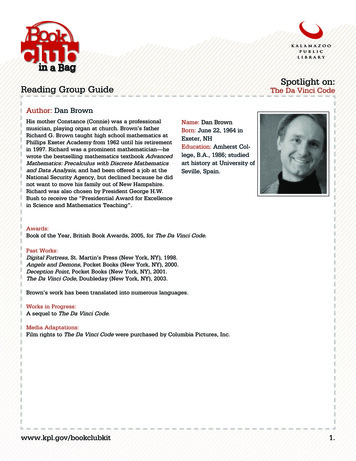
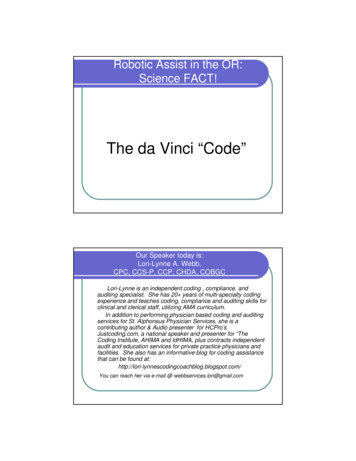
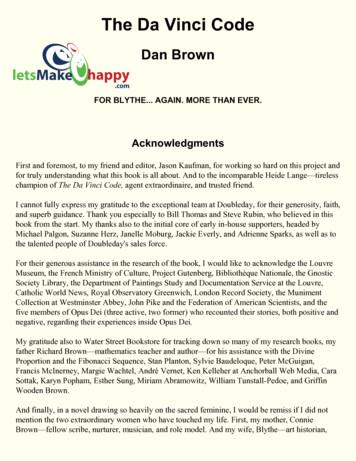
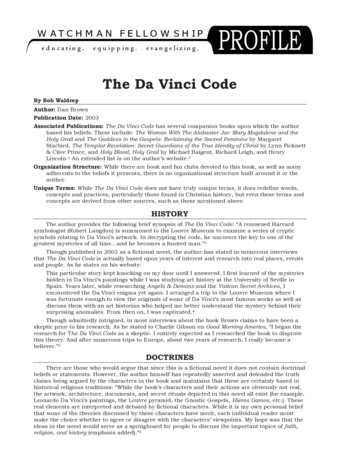

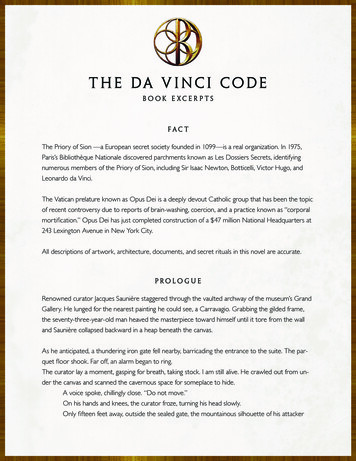
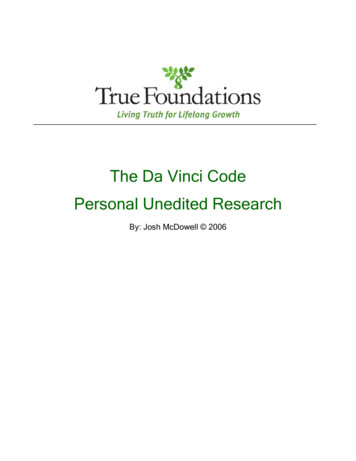
![Index [beckassets.blob.core.windows ]](/img/66/30639857-1119689333-14.jpg)
